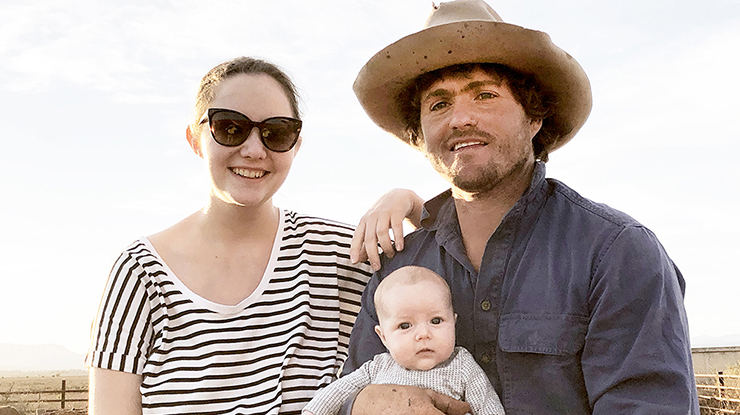Productivity flourishes in arid lands
21 March 2024
 Ben, partner Connie, and daughter Annie. Image: Ben Carn.
Ben, partner Connie, and daughter Annie. Image: Ben Carn.
Fifth generation sheep and beef producer Ben Carn’s careful land management, coupled with his ability to think on his feet and make the most of passing opportunities, have helped him thrive in the low-rainfall north-east SA pastoral region.
Attending workshops such as MLA’s one-day Grazing Fundamentals (Southern Rangelands) EDGE workshop is another way Ben positions himself to deal with challenging and changeable conditions at ‘Umberatana Station’, 100km from Lyndhurst.
Careful management
When it comes to managing land and livestock in his variable environment – where stock tend to favour areas with higher concentrations of more palatable feed – Ben said it’s vital to prevent overgrazing.
“If you let land condition get too poor, it will take a significant amount of time and effort to restore and the first thing to respond to rain on bare ground can be problem weeds like pimelea,” he said.
For example, a paddock of good feed at Umberatana is surrounded by hilly country, and stock prefer to stay on the flatter ground where the better feed is.
Ben plans to lock stock on the higher ground for at least eight months as a strategy to restore the Mitchell grass which used to flourish there, and protect sandalwood from overgrazing.
This will mean livestock are compelled to eat the less desirable – but adequate quality – feed they usually avoid when more palatable feed is available.
“It’s like if we have the choice of a good lunch we’ll go for it, but if it’s a dry old sandwich we won’t want to eat it as a preference,” Ben said.
“We’ve found putting younger sheep on harsher paddocks still allows them to grow well where older stock might not thrive, which hinders clean musters.”
Adequate nutrition
Ben provides additional nutrition as needed via molasses licks, in addition to urea – a practice reinforced by advice he received at the EDGE workshop.
“Molasses gives sheep the energy to go and find available feed and helps them handle the dry conditions. They’ll still do quite well on dry feed if we provide the licks,” he said.
“The licks also get the good bugs going in their gut so they can eat more while aiding with protein from the urea. I can’t just feed out hay because it’s not cost-effective for our enterprise.”
The Carns have a second property at Quorn, which they strategically use to prevent overgrazing at Umberatana.
“If we do have to remove stock from Umberatana to our southern property, we graze them with the addition of grain feeders in the paddock.”
Riding out the dry
Ben has grown accustomed to the environment at Umberatana – and it’s helped shape his pragmatic approach to the current climate challenges.
In late 2023, in response to reduced income from low cattle prices, he put some of the bigger projects – such as establishing new water points and building yards – on hold.
“We’re just holding on to ride it out,” Ben said.
Ben transports his own livestock with a prime mover which reduces freight costs.
“We can transport 60 head of cattle or 400 sheep at a time – we like to move them around a bit between our properties to take advantage of where the best feed is,” Ben said.
While Ben hasn’t needed to destock (as of December) due to sufficient feed being available – in the past destocking or agisting might have been the only option.


